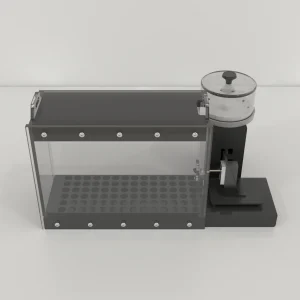$5,900.00 – $6,400.00Price range: $5,900.00 through $6,400.00
The MazeEngineers automated conditioned place preference system features two identical acrylic compartments linked by a central corridor, with the option to select your preferred color. Each compartment operates autonomously, providing independent control over animal location detection, lighting, and shock settings. The system includes removable acrylic panels, enabling customization of contexts during the CPP experiment. Optional automated doors can be added to your configuration. The entire setup also includes a removable top made of clear acrylic.

MazeEngineers empowers preclinical neuroscience research with meticulously designed, customizable behavioral apparatuses. From manual classic mazes to fully automated smart systems, we provide the tools scientists need to capture high-quality, reproducible data for studies on learning, memory, anxiety, and depression.

bool(false)


Mouse 3 Chamber CPP |
Three chambers |
Contextual plates: White; black; striped |
2 dual control shock grids |
2 dual control lights |
(Optional addon) Sound |
Rat 3 Chamber CPP |
Three chambers |
Contextual plates: White; black; striped |
2 dual control shock grids |
2 dual control lights |
(Optional addon) Sound |

The Automated Conditioned Place Preference Apparatus is an advanced adaptation of the traditional Conditioned Place Preference Test. This automated version enhances the standard setup with features such as infrared detection, separate controls for lighting, and independent shock grid management. The apparatus includes two equally sized acrylic compartments linked by a central corridor.
The Conditioned Place Preference Test is used to evaluate the rewarding and aversive effects of substances. Initially, rodents’ preference for one compartment over the other is assessed by recording the time spent in each compartment during a pre-conditioning phase. In the subsequent conditioning phase, the preferred compartment is associated with a control substance (e.g., saline), while the non-preferred compartment is paired with the drug. Rodents receive injections of either saline or the drug and are then confined to the corresponding compartment on alternate days. The post-conditioning phase, which mirrors the pre-conditioning phase but without drug or saline injections, assesses whether the rodent’s initial compartment preference has shifted due to conditioning. Each compartment features unique cues, helping animals link these cues with the reinforcer (Prus, James, & Rosecrans, 2009).
The Automated Conditioned Place Preference Apparatus is designed with independently controlled lights in both chambers to act as cues. The compartments can be equipped with interchangeable acrylic plates in white, black, or striped patterns to provide varied contexts. Additionally, each compartment includes a removable shock grid for administering shocks, which can be used as a form of reinforcement.
The Automated Conditioned Place Preference Apparatus features three acrylic compartments: two larger experimental chambers connected by a smaller central corridor. A clear, removable acrylic cover encases all three compartments.
The system includes interchangeable contextual plates in white, black, and striped patterns, along with two sets of independently controlled lights and shock grids. The removable shock grids can deliver currents ranging from 0.1 to 4.0 mA in 0.1 mA increments. Advanced infrared sensor mechanisms between the compartments enable automated detection and counting, complementing video tracking systems like the Noldus EthoVision XT. Each chamber operates autonomously, managing its own light, shock, and animal location detection functions.
Additionally, Conduct Science provides optional speakers for sound cues that can be installed in the experimental chambers. Automated guillotine doors can also be added upon request.
Thoroughly clean all compartments and bottom trays with isopropyl alcohol (70%) and dry them with a paper towel before each trial.
The following is a sample protocol to study conditioned place preference in rodents:
Transport the subjects from the animal housing room to the test room thirty minutes before the experiment. Allow the subject to habituate to the apparatus for a few minutes before the experiment.
The pre-conditioning phase is conducted to determine the subject’s baseline preference.
Place the subject in the apparatus with all the doors kept open. Allow it to move in all three chambers for 10 minutes freely. Remove the subject from the apparatus and return it to its home cage.
Start trials a day after pre-conditioning sessions. Pair the initially preferred compartment with saline solution and the non-preferred compartment with the drug.
Inject the subjects with the drug on the first day. Place the subject in the compartment paired with the drug for 30 minutes. Remove the subject from the apparatus. On the next day, inject the subject with saline and place it in the saline-paired compartment for 30 minutes. Conduct saline and drug trials on alternate days for 10 days.
Conduct post-conditioning trials a day following the last conditioning session. Conduct trials in the same manner as the pre-conditioning phase to observe if the subject developed a conditioned place preference.
Ebrahimiam et al. (2016) explored how antagonists of the orexin-1 receptor (OX1R) and orexin-2 receptor (OX2R) influence stress modulation and drug relapse using a reinstatement procedure in a conditioned place preference model. The study employed SB334867 as the OX1R antagonist and TCS OX2 29 as the OX2R antagonist, administered intradentate gyrus (DG) in one hundred and forty-four adult male albino Wistar rats with bilateral DG cannula implants.
Conditioned place preference was induced using the Conditioned Place Preference Apparatus, with subjects receiving 5 mg/kg morphine subcutaneously each day during a three-day conditioning phase. After conditioning, extinction of morphine’s rewarding effects was conducted in the same apparatus, analyzing the time spent in each compartment until the subjects’ conditioning scores on two consecutive days matched those from the pre-conditioning phase.
Twenty-four hours after meeting the extinction criterion, the rats were subjected to tests for drug priming-induced and forced swim stress-induced reinstatement. A morphine priming dose of 1 mg/kg was used for drug priming-induced reinstatement, and the Forced Swim Test was used to induce forced swim stress. The subjects were then placed back into the conditioned place preference apparatus ten minutes after receiving morphine or undergoing the forced swim stress test to evaluate drug-seeking behavior. Results showed that forced swim stress effectively reinstated drug-seeking behavior. The study also assessed the impact of intra-DG administration of OX1R and OX2R antagonists on reinstatement. The findings revealed that while these antagonists reduced drug priming-induced reinstatement, they had no significant effect on forced swim stress-induced reinstatement.
Niikura, Ho, Kreek, and Zhang (2013) examined the effects of oxycodone on conditioned place preference and locomotion in both adolescent (4 weeks old) and adult (10 weeks old) mice. The study utilized a conditioned place preference apparatus consisting of a white compartment with a stainless-steel mesh floor and a black compartment with a stainless-steel grid rod floor. One compartment was associated with saline, while the other was paired with oxycodone.
The mice were divided into four groups, each consisting of seven mice, and were administered different oxycodone doses: 0, 0.3, 1, and 3 mg/kg. During the conditioning phase, mice received injections of oxycodone or saline on alternate days. The results showed that adult mice developed a conditioned place preference with the lowest oxycodone dose (0.3 mg/kg), a response not seen in adolescent mice. Analysis of locomotor activity revealed that adult mice exhibited increased locomotion at oxycodone doses of 1 and 3 mg/kg, whereas adolescent mice only showed an increase in locomotion at the highest dose of 3 mg/kg.
The following parameters can be observed using the Automated Conditioned Place Preference Apparatus:
Using the Automated Conditioned Place Preference Apparatus, the following parameters can be monitored:
Even with prior habituation to the procedure, novelty-seeking behaviors in subjects may still impact the results. It is crucial for experimenters to be trained in gentle animal handling, as rough or stressful handling can diminish the effectiveness of conditioning. Additionally, factors such as the strain, age, or gender of the subjects can also affect the outcomes.
| Chamber | Mouse 3 Chamber CPP, Rat 3 Chamber CPP |
|---|
There are no questions yet. Be the first to ask a question about this product.